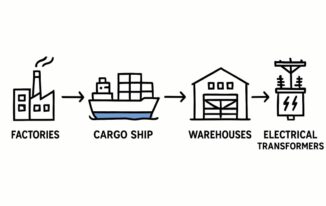Key Takeaways
- Electrical supply chains face significant material shortages, particularly critical assets like transformers and electrical steel, which undermine project timelines and reliability.
- Geopolitical instability and evolving trade policies force a strategic shift towards domestic manufacturing and supply security, fundamentally altering sourcing strategies.
- Technological breakthroughs—such as artificial intelligence and advanced automation—are proving transformational in optimizing inventory, logistics, and risk management.
- Sustainability is no longer optional; industry leaders are embedding environmental responsibility through circular economy principles and eco-friendly procurement.
Table of Contents
- Introduction
- Material Shortages and Supply Chain Bottlenecks
- Geopolitical Influences and the Shift Towards Domestic Production
- Technological Advancements Enhancing Supply Chain Efficiency
- Sustainability Initiatives and the Circular Economy
- Strategies for Building Resilient Supply Chains
The global demand for electrical products is increasing due to urban infrastructure, electrification, and renewable energy projects. This has led to challenges like sourcing, logistical issues, and sustainability, requiring industry stakeholders to adapt. In this fast-evolving environment, having the right partners—such as a trusted PVC conduit supplier—has become desirable and essential in ensuring supply chain continuity and operational resilience from the ground up. Strategic adaptation, marked by innovation and the swift embrace of technology, is now central to how companies can respond to escalating challenges. Simultaneously, the drive for greater sustainability demands new thinking across every supply chain link, from raw material sourcing to delivery. This article delves into the latest pain points faced by the electrical sector. It highlights the pioneering solutions that keep businesses afloat and reposition them for robust future growth in an unpredictable world.
Material Shortages and Supply Chain Bottlenecks
One of the most pressing challenges facing the electrical supply industry is the shortage of essential materials. These issues permeate every stage of operations, from initial procurement to end-user delivery. The scarcity is particularly severe in the availability of transformers and electrical steel, which are indispensable for infrastructure modernization, grid upgrades, and renewable integration. Global lead times for high-voltage transformers have surged; orders now commonly take up to three years to fulfill due to production, testing, and transport complexities. Even distribution transformers—vital for commercial, industrial, and residential applications—can involve delays surpassing a year.
This grim reality is compounded by a heavy dependence on international sources for these materials: up to 80% of high-voltage transformers and roughly half the distribution transformers are still imported. Such dependencies heighten exposure to global supply chain disruptions, currency fluctuations, shipping delays, and political uncertainties. Consequently, addressing these shortages demands a dual approach. Companies must urgently modernize local manufacturing capabilities, invest in process innovation, and establish robust relationships with reliable partners. For example, collaborating with a specialized PVC conduit supplier helps ensure access to vital components even during surges in demand, bridging critical gaps and keeping infrastructure projects on track.

Geopolitical Influences and the Shift Towards Domestic Production
Geopolitical uncertainty, including escalating trade restrictions, new tariffs, and unpredictable cross-border regulations, has reshaped the global supply chain landscape. These macroeconomic forces have exposed vulnerabilities in long-standing overseas sourcing strategies, frequently leaving businesses scrambling to adapt midstream. The electrical industry, which is strategically essential to national and economic security, is susceptible to these shifts.
In response, North American manufacturers and suppliers are actively reshoring production, fostering more autonomous and secure supply systems. Recent examples, such as ABB’s significant $120 million investment in expanding U.S. production of low-voltage electrical equipment, exemplify this realignment. By ensuring that facilities within the U.S. serve more than 90% of domestic demand, companies like ABB are reducing lead times, stimulating local economies, and enhancing national resilience. These moves also support greater compliance with future regulatory changes and help insulate business operations from disruptive diplomatic events, all while guaranteeing customers more predictable and flexible service options.
Technological Advancements Enhancing Supply Chain Efficiency
Technology is rapidly redefining the possibilities within modern supply chains. Artificial Intelligence (AI), big data analytics, and process automation are at the heart of this revolution, allowing companies to solve intricate logistical challenges and pursue new levels of efficiency. AI-powered tools process real-time supplier and demand data, facilitating predictive inventory management, dynamic routing, and smart order fulfillment. This means fewer stockouts, reduced operational downtime, and minimized waste, even as customer expectations and demand complexities intensify.
A notable application of digital transformation is the adoption of digital twins—detailed virtual representations of entire supply chains. These tools enable the simulation of countless scenarios, fostering proactive risk mitigation and rapid adaptation to sudden market shocks. Companies using digital twin models can closely monitor every facet of their operations, anticipating bottlenecks, testing contingency plans, and optimizing responses with scientific precision. According to McKinsey Supply Chain Insights, such innovations are indispensable for achieving supply chain agility, transparency, and competitiveness amid today’s volatility.
Modern supply chain leaders deploy AI-driven planning systems that automatically regulate procurement in response to fluctuating market dynamics, ensuring optimum inventory without overstock or shortages. Robotics and warehouse automation technologies further streamline picking, sorting, and packing processes, transforming warehouses into high-speed, low-error environments. With connected systems providing real-time alerts, electrical supply companies can swiftly reroute supplies and resolve disruptions, guaranteeing uninterrupted service and fortifying customer relationships.
Sustainability Initiatives and the Circular Economy
Sustainability now sits at the center of strategic electrical supply chain planning, going well beyond regulatory box-ticking. Circular economy models—in which the lifecycle of electrical components is extended through refurbishment, recycling, and responsible end-of-life processing—are taking root across the industry. By diverting millions of tons of electrical waste from landfills or incineration, these practices dramatically reduce environmental impact and buffer companies against resource scarcities and price volatility.
On the operational side, sustainability means adopting energy-efficient production methods, opting for lower-emission transportation options, and selecting raw materials with robust environmental certifications. These green initiatives provide tangible payoffs, too: aligning with consumer and investor expectations, preempting future compliance risks, and strengthening brand reputation as a leader in responsible industry practice.
Strategies for Building Resilient Supply Chains
Diversifying, robust partnerships and proactive digitalization achieve supply chain resilience. Rather than relying solely on one supplier or region, leading firms spread their sourcing across multiple partners to hedge against isolated disruptions. Expanding or upgrading domestic manufacturing delivers greater visibility and control over production cycles, helping to circumvent international shipping delays and regulatory hurdles.
End-to-end supply chain management systems leverage advanced analytics for continuous risk assessment, enabling real-time responses to emerging threats or bottlenecks. Strategic investments in employee upskilling, workforce flexibility, and innovation serve as additional safeguards, empowering teams to adapt swiftly amid uncertainty. Trusted supplier relationships are central to this web; engaging with proven experts ensures reliable access to core materials, builds mutual trust, and supports transparent information sharing that underpins effective collaboration and continuous growth.
Conclusion
The future of electrical supply chains is unfolding rapidly, shaped by the dual imperatives of technological excellence and sustainability. Companies that rise to the occasion by actively tackling shortages, reengineering sourcing models for resilience, and integrating next-generation innovations mitigate today’s obstacles and set themselves up for long-term relevance and profitability. Thoughtful integration of circular economy practices, digital supply chain strategies, and trusted, long-term supplier partnerships positions businesses to thrive amid uncertainty. Those who lead with agility and vision will secure their place in the market and contribute to a more sustainable, efficient, and prosperous electrical industry for decades.



